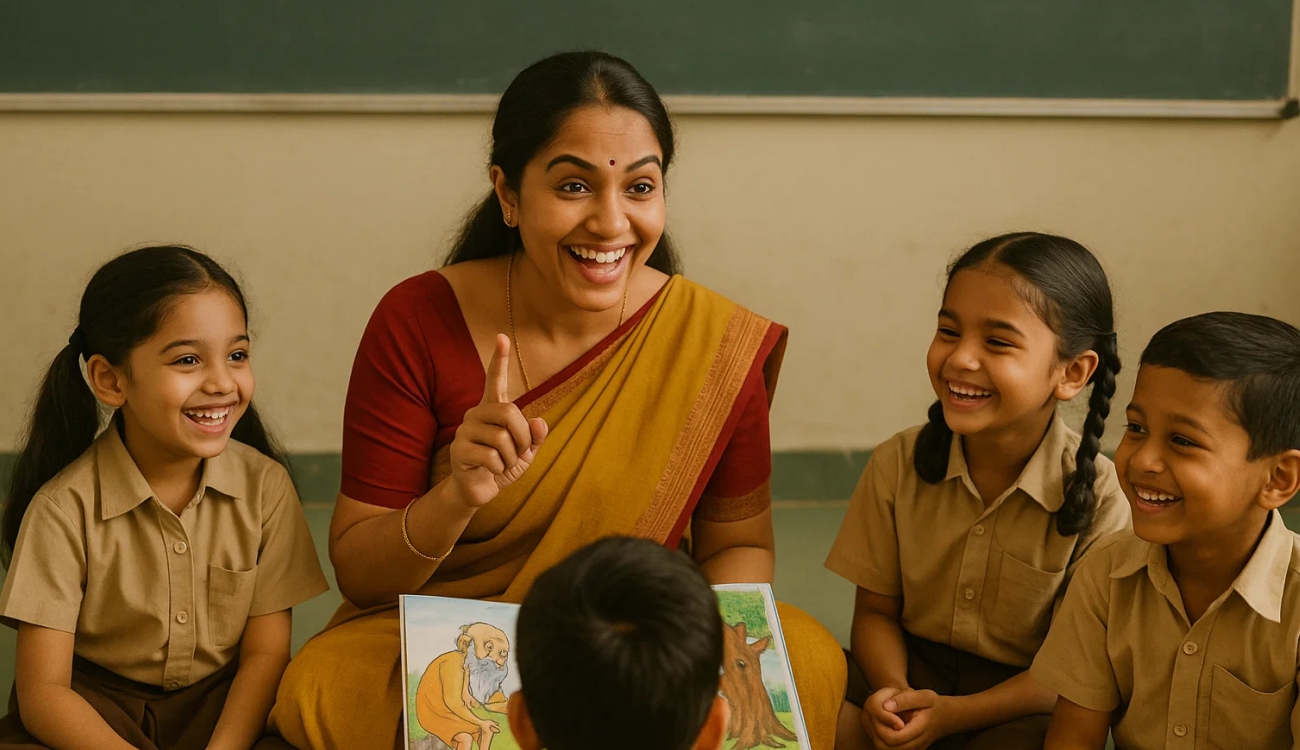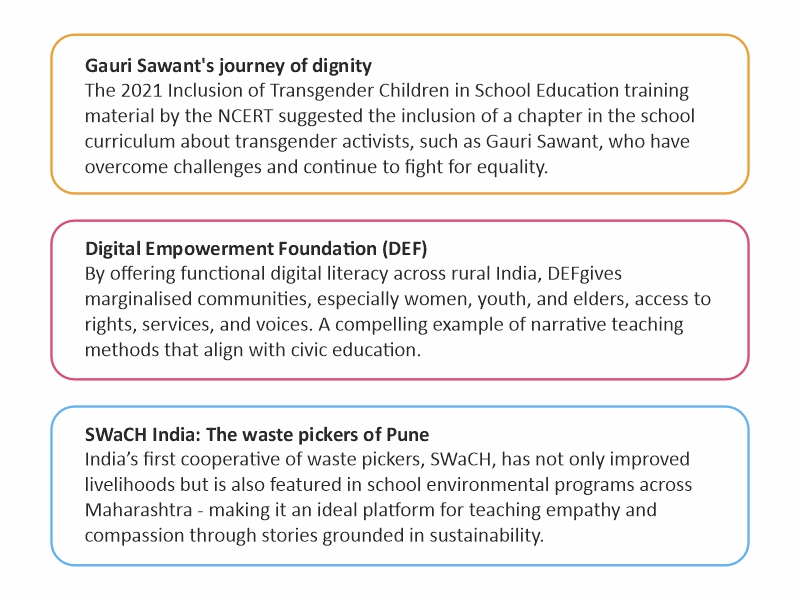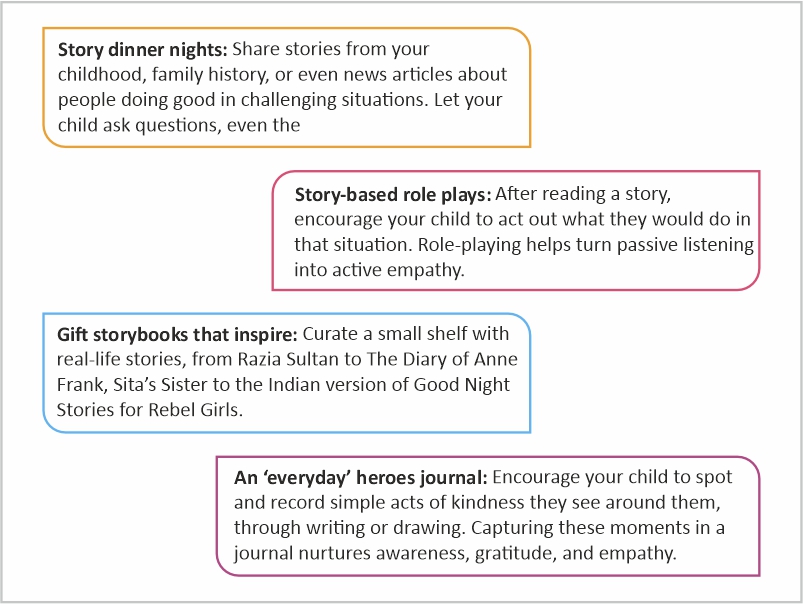![]()
Bringing human experiences into lessons to nurture compassion and global citizenship.
| In this article, you’ll explore: • Why real stories belong in classrooms too • India’s own storybook: Real lives, impactful lessons • Real-world impact from India’s classrooms • Stories from across the world that resonate in India • Why it works: Bringing storytelling to life • How to use humanitarian stories in classroom discussions • What can parents do at home? • The road ahead: Normalising narratives through policies |
Batman fights crime.
Spider-Man swings through skyscrapers.
Iron Man builds suits.
Shaktimaan channels his cosmic energy.
Doga takes down the underworld.
Nagraj summons his serpents to strike.
Sure, superheroes save cities.
But have you met real-life superheroes such as Babar Ali, who became the world’s youngest headmaster at the age of nine? Or Srishti Goswami, who served as Uttarakhand’s Chief Minister for a day at 19? Or school kids in Varanasi, who planted thousands of trees during a drought?
These are the quiet heroes. And their humanitarian stories in education are transforming the way students understand the world.
Why real stories belong in classrooms too
Education doesn’t just involve math and maps. It is more about making sense of the world and one’s place in it. That’s where storytelling in classrooms becomes powerful, particularly when it involves incorporating narratives in teaching that reflect human courage, resilience, and justice.
The 2024 journal The Effectiveness of Storytelling in Enhancing Empathy in Bilingual Kindergarten Students mentions that, by engaging with fictional narratives, children gain a safe space to explore and understand complex emotions.
When we incorporate humanitarian education in schools, we make lessons feel more real and impactful.
India’s own storybook: Real lives, impactful lessons
Across India, real-life narratives are turning into powerful teaching tools, shaping how students learn about empathy, justice, and social change.
Real-world impact from India’s classrooms
These initiatives demonstrate that when students encounter stories grounded in reality, they not only learn but also grow.
- Ashoka University’s Human Library in Delhi: At Ashoka University, students sat face-to-face with real-life heroes, acid attack survivors, refugees, and social workers, who shared their personal stories. These dismantled students’ assumptions and demonstrated the power of stories in learning.
- Bengaluru’s “Classroom on Wheels”: A mobile classroom launched in July 2025 in Doddakallasandra, Bengaluru – the Eco‑Savaari initiative – brings interactive lessons on biodiversity, climate change, snake awareness, and water management directly to schools.
- Madhya Pradesh’s “Anand Sabha”: From 2025-26, all government high schools and higher secondary schools in Madhya Pradesh plan to initiate Anand Sabha, a weekly student gathering in Classes 9–10, featuring storytelling, games, and mindfulness, to foster empathy, moral values, and emotional well-being.
Stories from across the world that resonate in India
Global humanitarian narratives serve as powerful tools in Indian classrooms, reflecting the values we hold dear. These stories urge students to feel, think, and act with greater purpose.
- Malala Yousafzai: Malala’s fight for girls’ education has inspired schools across India to host readings and reflections on “I Am Malala,” encouraging students to value education and speak up for their rights.
- Alan Kurdi: Alan Kurdi’s story has been powerfully integrated into classroom learning, prompting students to reflect deeply on the experiences of refugees and develop empathy. The model described in 2024 Promoting Students’ Engagement and Empathy toward Refugees through the Illustrated Book Sea Prayer, encourages empathetic engagement through art, interviews, and storytelling.
- Amanda Gorman: Amanda Gorman’s “The Hill We Climb” is used in classroom discussions on humanitarian issues, exploring how art and words can drive change.
………………………………………………………………………………………………………
Why it works: Bringing storytelling to life
Last year, I read a short story to my students about a boy displaced due to floods. As I read, the room fell silent. One student, usually lost in her desk, sat upright, eyes glued to the page.
After class, she whispered, “Ma’am, I’ve never been in a flood. But I felt like I was there.”
That moment has stayed with me. Later, I discovered research by Dr. Uri Hasson of Princeton, who found that when we listen to a compelling story, our brain waves sync with the storyteller’s. It is called neural coupling, a kind of mind-to-mind connection that makes stories more than just words.
That’s the quiet magic of a good story. It makes the unfamiliar feel personal.
………………………………………………………………………………………………………
How to use humanitarian stories in classroom discussions
Begin with a story, not a statistic
Instead of “10 million child labourers in India,” begin with the story of Lakshmi, a 13-year-old who escaped bonded labour and now advocates for children’s rights.
- Why it matters: Stories build emotional connection. Data alone can’t do that.
Link stories to the curriculum
Connect real-world stories to classroom concepts, such as Sonam Wangchuk’s ice stupas in Ladakh for lessons on climate resilience, or Aruna Rai’s RTI campaign to explore civics and activism.
- Why it matters: Stories help students apply empathy to what they are already studying.
Use authentic, first-person accounts
Use real voices from platforms such as YuWaah by UNICEF India, Youth Ki Awaaz, and Kalki Subramaniam’s Red Wall Project for great reference points.
- Why it matters: Incorporating real-life humanitarian narratives in lessons gives faces to facts.
Create dialogue, not debate
Humanitarian storytelling works best when followed by guided classroom discussions with open-ended questions, such as, “How would you feel in their shoes?” or “What could you have done differently?”
- Why it matters: Encourages students to think deeply rather than argue loudly.
What can parents do at home?
The road ahead: Normalising narratives through policies
The National Education Policy 2020 mentions that the school curriculum will include, from the outset, material on human values such as respect for all persons, empathy, tolerance, human rights, gender equality, non-violence, global citizenship, inclusion, and equity.
Embedding humanitarian narratives into the national curriculum is an essential pedagogical approach. To raise thoughtful citizens, schools must look past blackboards and into the hearts of lived experiences. Because the benefits of storytelling in education for social awareness extend beyond test scores, they build character.
In a world that often rushes past quiet struggles and silent heroes, storytelling in the classroom slows us down, just enough to notice, feel, and care. When classrooms become spaces where humanitarian stories in education are heard, felt, and understood, education moves beyond exams and enters a place of empathy. Because before our children can change the world, they must first see it, not as chapters in a textbook, but as lives lived, rights fought for, and hope carried forward. And that begins with a story.




